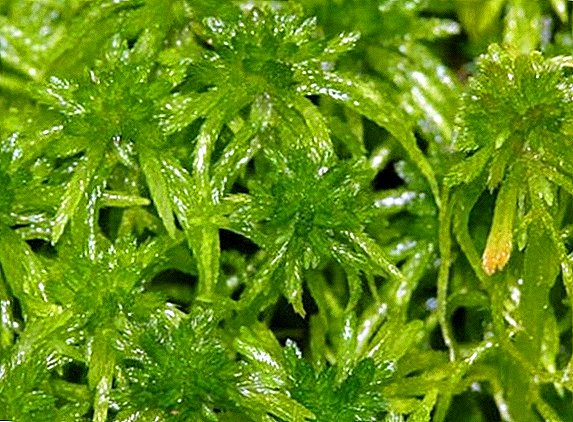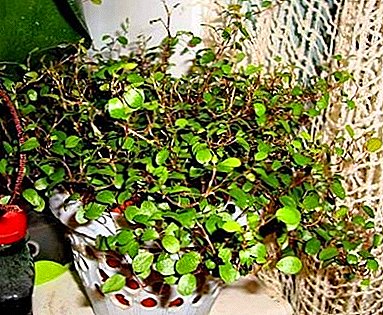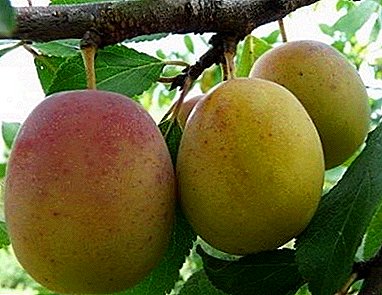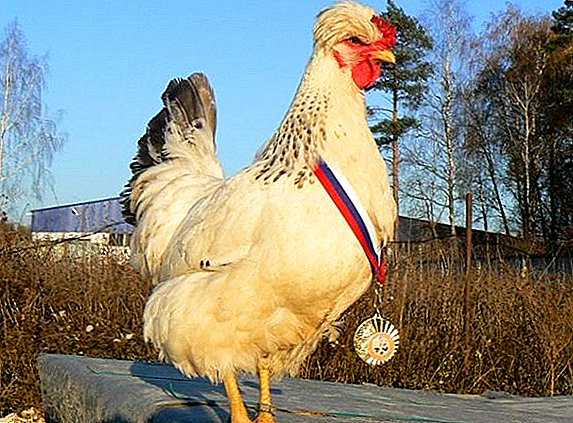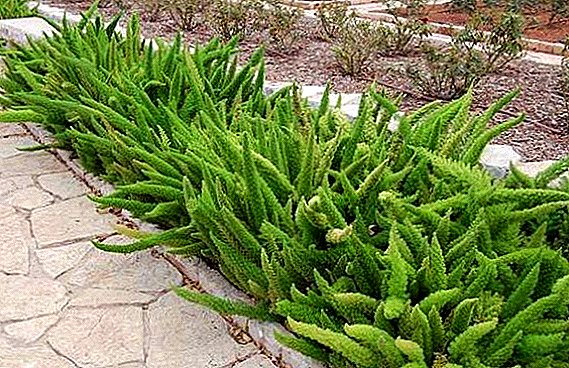 Many florists complain that asparagus turns yellow and showered, so this article is designed to tell you what to do with a sick plant and how to identify the causative agent of the disease.
Many florists complain that asparagus turns yellow and showered, so this article is designed to tell you what to do with a sick plant and how to identify the causative agent of the disease.
Possible problems and diseases of asparagus, treatment methods
Asparagus belongs to the asparagus family. This is a perennial liana, which has thin flexible stems and leafy shoots resembling needles. The fruits that are formed after flowering are bright red.
Although asparagus and unpretentious to the conditions of detention and a great winter in cold climates, it can affect various diseases and parasites, after which the plant takes a painful look and needs to be rescued.
Asparagus turns yellow and showered
If asparagus turns yellow and leaves start to crumble, then you need to pay attention to the following factors:
- soil moisture;
- lighting;
- air humidity in the room;
- the size of the pot corresponds to the size of the root system.
Thus, if you have flooded the plant too much or have not watered it for a long time, then it can become “sick”. Poor or too strong illumination will also lead to yellowing of the leaves. Dry air or a pot that is too small give the same effect.
 Why does asparagus turn yellow? Yellowing and falling leaves - a reaction to improper care. If you do not change the conditions of detention, you can lose the plant.
Why does asparagus turn yellow? Yellowing and falling leaves - a reaction to improper care. If you do not change the conditions of detention, you can lose the plant.
Cure asparagus is not difficult. To begin, cut off all the bare shoots and try to adjust the mode of watering and lighting. First of all, you need to remember the moment or action, after which the plant began to hurt.
Important! If asparagus fell ill in the winter, then after pruning the shoots it must be removed from batteries and other heat sources.
To further asparagus not capricious, observe the following rules:
- increase the humidity in the room, as dry air is detrimental to the flower;
 water the plant properly, increasing the amount of moisture you pour in spring and summer, and reducing it in winter;
water the plant properly, increasing the amount of moisture you pour in spring and summer, and reducing it in winter;- give asparagus the maximum amount of sunlight by placing it on the south side (however, make sure that the midday rays do not fall on the plant);
- feed every two weeks with complex mineral fertilizers;
- repot the plant before the roots occupy the entire space of the pot.
Did you know? Asparagus is considered the birthplace of humid areas of South America, Southern and Eastern Africa, and Asia.
The flower withers and nikta
The main cause of this disease is a surplus of moisture in the soil. The plant, though it likes high humidity, is not without problems with root rot.
 What threatens to excess moisture for indoor asparagus? If you do not dry the soil in time, then the roots will simply begin to rot. At the initial stage, this is fixable, but if the entire root system decays, the flower will die.
What threatens to excess moisture for indoor asparagus? If you do not dry the soil in time, then the roots will simply begin to rot. At the initial stage, this is fixable, but if the entire root system decays, the flower will die.
If the pot is really waterlogged soil, then the plant should be carefully pulled out and check the roots. Rotten parts are removed and sprinkled with chips of activated charcoal or other antibacterial agent. After pruning, you need to plant a flower in fresh, dry soil. After planting, slightly moisten the ground and observe the plant in the following days.
You need to follow the rules of care, which directly affect the condition of the flower.
- Water the plant depending on weather conditions and room temperature. Do not be afraid to once again touch the soil in the pot to make sure that you need watering. The soil should be slightly moist and crumbly.
- Loosen the ground so that the roots of the plant receive oxygen.
- Be sure to put a drain on the bottom of the pot, which helps to remove excess water.
- Use light soil that does not trap moisture.
Pale leaves

If the flower is pale leaves, it lacks sunlight. As you know, sunlight plants use to synthesize the right elements. The lack of coverage is the reason why asparagus does not grow well.
This state is not dangerous for asparagus, however, at the same time the plant immunity decreases and there is a risk of various diseases.
Pale leaves are cut by transferring the plant to the sunny side and feeding. So that in the future asparagus leaves do not turn pale, try to give the plant a maximum of sunlight during the period of rapid growth and flowering.
Did you know? Chlorophyll, which stains the leaves of plants in green and participates in photosynthesis, is also used as a food additive E140.
Spots on the leaves
 If the leaves of your plant are stained, you should not immediately run to the store for drugs from diseases or pests. Plant spots are the usual sunburns that a plant can get from the noon rays of the sun.
If the leaves of your plant are stained, you should not immediately run to the store for drugs from diseases or pests. Plant spots are the usual sunburns that a plant can get from the noon rays of the sun.
Leaf burns are very unpleasant for the plant, as they cause damage to the organs responsible for photosynthesis. Thus, if the plant is not removed in time from the scorching sun, it can dry out.
Important! You need to carefully examine the plant for the presence of small bugs or other living creatures, since many parasites can cause similar symptoms.
Burns are treated very simply: you need to remove the plant for 1-2 days in partial shade, increase the humidity of the air, water the flower (if the soil is dry) and add a small amount of complex fertilizers.
To further the flower did not suffer from the sun, try in the late spring - early summer not to put asparagus in the sun from 11 to 3 o'clock in the afternoon.
The edges of the leaves turn brown.
 The edges of the leaves of asparagus turn brown due to lack of moisture and too much light. It turns out that the body of the plant in the heat evaporates a lot of moisture, and in return it does not flow, because the roots are dry.
The edges of the leaves of asparagus turn brown due to lack of moisture and too much light. It turns out that the body of the plant in the heat evaporates a lot of moisture, and in return it does not flow, because the roots are dry.
If you notice the problem in time, water the plant and remove it from the sun, there will be no consequences for asparagus.
You should as soon as possible remove the plant in the penumbra and water it. Also spraying the ground part will not hurt. If the room is very hot, then transfer asparagus to a cool place for at least a few hours so that the moisture lingers longer in the plant. It is important to understand that these symptoms can cause pests, so carefully inspect the plant.
Slowing asparagus in growth
Sometimes the slowdown is very difficult to notice, but if the flower does not grow at all, then this is quite a serious problem. If asparagus does not grow well, it means that it lacks nitrogen and iron, which are introduced in combination with other essential substances. Slow growth may also indicate a cramped pot.
 In fact, there may be a lot of reasons, so carefully examine the whole plant. If you notice the roots sticking out of the ground, then an urgent asparagus transplant is needed. Dry soil should be watered and burst. Do not forget to check the inside of the leaf and basal neck, because it is there that pests that can slow down growth often parasitize.
In fact, there may be a lot of reasons, so carefully examine the whole plant. If you notice the roots sticking out of the ground, then an urgent asparagus transplant is needed. Dry soil should be watered and burst. Do not forget to check the inside of the leaf and basal neck, because it is there that pests that can slow down growth often parasitize.
To ensure that asparagus grows well and does not hurt, follow the regime of watering and lighting, apply complex fertilizers twice a month and replace the flower in a timely manner.
How to deal with asparagus pests
Asparagus is sick due to pests that, even indoors, can parasitize on a flower. The above symptoms can cause microorganisms, so it is worth examining them in detail to be sure of the cause of the disease.
Spider mite
A very small parasite that does not immediately catch the eye. May be colored red, orange or yellow. Often spider mite is confused with the usual because of the similarity of the structure. It is worth noting that the spider mite parasitizes only on the plant and the person can not do any harm.
Did you know? Spider mites live on all continents except Antarctica.
A mite can get into an apartment or house through an open window (with raindrops or a gust of wind), along with tools or earth.
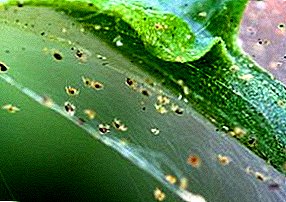 The pest likes dry air and hot weather. The air temperature directly affects the rate of reproduction (at a temperature of +30 С, pending larvae hatch in two days). The appearance of the pest can be both in the summer and in the winter (the heating in the house dries the air and creates optimal conditions).
The pest likes dry air and hot weather. The air temperature directly affects the rate of reproduction (at a temperature of +30 С, pending larvae hatch in two days). The appearance of the pest can be both in the summer and in the winter (the heating in the house dries the air and creates optimal conditions).
How to understand that the plant is affected by spider mites?
An incomprehensible transparent web will appear on asparagus (in this case, you shouldn’t sin on room spiders, as this is the very first sign of mite damage). The leaves form small yellowish spots, which then merge into several large ones.
Similar symptoms can be observed with sunburns, therefore, before baiting the pest, carefully inspect the plant. A spider mite, ignored, will take all the nutrients out of the plant. The leaves will turn yellow and the plant will dry.
Asparagus is sick, stained and dries due to the activity of the tick, what to do? It is difficult to treat the plant with chemistry, as insecticides indoors are very dangerous for humans and domestic animals.
Try folk methods:
- Treat the plant with a solution of household soap. Lightly moisten the leaves and shoots with lather, trying not to get to the ground.
- Infusion on garlic. On 1 liter of water, 20 g of garlic husks are taken and infused for five hours. Next, the solution is sprayed with a spray on the entire plant.
Prevention of mite is to maintain high humidity in the room or regular spraying of asparagus (but not watering!).
Thrips
 Small insects that have a length of up to 5 mm and dark color of the little body. The parasite is distributed throughout the world and has more than 6 thousand species.
Small insects that have a length of up to 5 mm and dark color of the little body. The parasite is distributed throughout the world and has more than 6 thousand species.
The pest appears on a weakened plant that has not been watered for a long time, kept in a poorly lit room, or is not fed.
Symptoms:
- the appearance of whitish "tracks" on the leaves;
- faded spots on the leaves;
- deformed leaves or flowers;
- curvature of the stem.
For the treatment, fungicides are used, namely: "Vertimek", "Aktelik", "Confidor" and "Karbofos".
Important! Asparagus reacts poorly to chemicals, so choose a weak remedy so as not to destroy the plant.
Thrips can be expelled by folk remedies. To do this, the plant is treated with broths of celandine, chilli and yarrow.
Prevention measures:
- spraying asparagus;
- inspection of the flower for the presence of parasite larvae;
- placing sticky yellow traps near the plant or on it.
Aphid
A small insect from the order of hemiptera. Aphid affects almost all plants, not disdaining and indoor flowers.
 Aphid can be brought home with a bouquet of flowers or a new plant from a flower shop. Also, the insect can move through the air and get into the apartment through an open window. The parasite attaches to asparagus and starts drinking juices. In addition to direct damage, the aphid carries also dangerous viral and bacterial diseases of plants.
Aphid can be brought home with a bouquet of flowers or a new plant from a flower shop. Also, the insect can move through the air and get into the apartment through an open window. The parasite attaches to asparagus and starts drinking juices. In addition to direct damage, the aphid carries also dangerous viral and bacterial diseases of plants.
If asparagus struck aphid, then soon its leaves will begin to curl and deform, the flowers - to dry without blooming. Nutrient deficiencies can result in leaf bleaching or drying. The waste products of aphids remain on asparagus, making it difficult for him to breathe. The excrement of aphids attract different types of fungi that will also interfere with the plant.
Aphid is treated both with folk methods and with the help of chemistry.
To remove the pest, you can use the following infusions and decoctions:
- Garlic or onion infusion. On 1 liter of water take 30 g of garlic and 4 g of soap, insist at least eight hours. After that, asparagus is treated several times with an interval of 10-12 days.
- Processing with pure alcohol. Rub the entire ground portion of asparagus.
- Spraying infusion of hot peppers. In 1 liter of water boil 100 g of fresh pods for about an hour. After that, the broth is diluted with water in a ratio of 1:10.
Prevention measures:
- proper care;
- frequent inspection of the plant;
- fertilization;
- spray from spray.
Redhead
 The parasite belongs to the family of even-winged insects. It looks more like a white wood louse or some kind of beetle (furry louse - called the worm in the people), has a length of up to 6 mm and is similar to the shield. Parasites appear on asparagus due to poor maintenance (low temperature, excessive watering, rotten plant debris). Worm can also be brought into the house with contaminated soil or plants.
The parasite belongs to the family of even-winged insects. It looks more like a white wood louse or some kind of beetle (furry louse - called the worm in the people), has a length of up to 6 mm and is similar to the shield. Parasites appear on asparagus due to poor maintenance (low temperature, excessive watering, rotten plant debris). Worm can also be brought into the house with contaminated soil or plants.
It can be recognized by white patina, which resembles cotton wool or fine snow. Affected leaves turn yellow and deform. Like aphid, the hairy louse leaves its excrement on the plant, on which the fungus develops.
Did you know? Some types of worm are used to produce dyes and varnishes.
The pest is dangerous because it sucks the sap of the plant and slows its growth. Only huge colonies of this parasite can cause asparagus to dry out.
To cure the plant is easy. In the early stages, the flower is treated with soapy water several times at weekly intervals. If the whole bush is covered with parasites, then it is necessary to resort to chemical preparations: Aktara, Calypso, Mospilan, Konfidor.
Fight against the worm folk methods:
- Alcohol infusion with soap. Per liter of water take 15 g of liquid soap and 10 ml of denatured alcohol. Spray the plant with the mixture.
- Infusion on garlic. On a half-liter jar of water take 5 cloves of garlic. Water is boiled and steamed crushed garlic. After that filter, dilute 1: 5 with water and process asparagus.
Prevention measures:
- Do not overmoist the soil;
- conduct regular pest checks;
- remove dry leaves and shoots in time;
- bathe in the shower and rinse the leaves.
Shchitovka
 The pest belongs to the hemiptera family. The shield has a length of up to 3 mm and a grayish-white color. The main reason for the appearance is overdried air and high temperature. A shield can also be brought home on another plant or bouquet.
The pest belongs to the hemiptera family. The shield has a length of up to 3 mm and a grayish-white color. The main reason for the appearance is overdried air and high temperature. A shield can also be brought home on another plant or bouquet.
Symptoms:
- small light growths in the places of adhesion of the leaf to the shoots;
- raid along the veins of the leaves;
- yellowing and premature leaf fall.
Do not underestimate these microscopic pests. Shchitovka causes significant damage to the plant (a large colony can easily destroy even a large tree). Since the parasite feeds on the plant sap, damaging the integrity of the shoots, asparagus loses nutrients and cannot breathe normally. In the wounds gets another infection that brings a "bunch" of other problems and diseases.
With the shield you need to fight and delay it is impossible. Asparagus can be treated with both folk methods and insecticides.
Important! Do not forget that the plant tolerates chemicals very poorly and should be used as a last resort!
The most common insecticides that will quickly bring out the shield are Aktara, Mospilan, Confidor, and Golden Spark.
However, it is worth knowing that it is impossible to deduce an adult flap with insecticide treatment, therefore the only option is mechanical removal. To do this, use a cotton pad moistened with an insecticide solution. Do not forget to irrigate the ground part of the plant with water. Often, due to dry age, this disease occurs. 
Preventive measures against diseases
Each disease is looking for the vulnerable place of the plant, so the best prevention is the right care. Feed asparagus in time, remove dry and rotten parts of it, monitor the room temperature and air humidity. Slightly wet soil - a guarantee of plant health. Do not forget about drafts and sudden temperature changes that asparagus does not like. Replant and divide the flower in time to not only accelerate the growth of asparagus, but also to get another young plant.
Follow the principle: "comprehensive care is the best medicine."


 water the plant properly, increasing the amount of moisture you pour in spring and summer, and reducing it in winter;
water the plant properly, increasing the amount of moisture you pour in spring and summer, and reducing it in winter;
